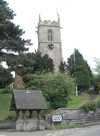 Kirton Kirton
Holy Trinity
History
There is no mention of a church under Kirton in Domesday Book. The earliest fabric of the church appears to date from the 13th century. Surviving 13th Century work includes the north arcade, chancel arch, north doorway, and south porch doorway. The west tower is 15th century, Perpendicular in style.
Thoroton, in Antiquities of Nottinghamshire, describes Holy Trinity as linked to Blyth Priory as a member of ‘the chapelry of Blyth’. This was a Benedictine Priory founded in 1088 by the Norman Lord Roger de Builli. In a charter of King John, Kirton is certainly a dependency of Blyth, being described, along with several other churches, as ‘Ecclesiam de Westmarcham cum capellis de Kirketon, … cum omnibus pertinentiis suis.’ Another monastic foundation that had significant interest in the area was Rufford Abbey, which was gifted a number of land holdings in Kirton. Rufford Abbey was a Cistercian monastery founded towards the end of the reign of King Stephen by the Earl of Lincoln. Thoroton comments that despite Hugh Fitz Ralph gifting all of his demesne in Kirton to Rufford Abbey, the advowson of the church remained with his heirs.
In the late twelfth century patronage of the church of Holy Trinity, as part of the chapelry of Blyth, was given to Rouen Cathedral. In 1174 Henry II had granted to his clerk Walter of Countances the gift of the chapelry of Blyth. In 1191 the future King John, Count of Mortain, confirmed this gift to Walter of Courtances, then Archbishop of Rouen.
Holy Trinity, Kirton is listed in the 1291 taxatio returns. This was an assessment for tax ordered by Pope Nicholas IV. The annual value of the benefice is given as £8. The 1428 subsidy tax records of Henry VI show that the value of the church had remained the same. The subsidy for Kirton is 16s, which is 10% of the overall value, 12 marks or £8.
In 1538 the parish registers for Kirton began.
A churchwarden presentment of 1603 gives details of the minister, value of the parsonage and congregation numbers. The minister is described as ‘a preacher and Bacheler of Divinitie’. The parsonage ‘in the King's Books is £7 15s 6d’. There were ‘81 communicants and no non-communicants’.
A churchwarden presentment of 1663 provides a more detailed description of the state of the church. This includes an account of the contents of the church:
we have a font decently placed in the accustomed place and we have a cover; we have a communion table in good repair and conveniently placed, but not a decent carpet, although we have a fair linen cloth and a handsome cup of silver with a cover for the same; we have no flagons of pewter, but one is always provided for the use of the communion; we have a decent reading desk and pulpit with a cushion and cloth; we have a large common prayer book and a Bible but we want a book of homilies and canons; we have a table of degrees wherein marriage is forbidden and a decent surplice but we have no hood … we have a book to record the names and licenses of such strangers as are admitted to preach; we have a chest, but want a box for alms, which shall be provided.
The parsonage house was ‘in tolerable repair’.
In 1677 Thoroton recorded the patron of Holy Trinity as the Earl of Clare and the value of the rectory as £7 14s 9d.
Thomas Herring, Archbishop of York, toured the diocese in 1743. A visitation report includes details of Holy Trinity. The parish had 32 families. There was only one dissenter, a man who sometimes attended Presbyterian meetings. The Rev William Boawre resided in his parish and had no curate.
By 1764 in the records from the visitation of Archbishop Drummond the number of families in the parish had fallen to 28. There was still only one dissenter, described as ‘a farmer who pretends to be a Calvinist, but very seldom goes to any place of public worship’.
In the 1790s revision of The Antiquities of Nottinghamshire, Throsby listed the patron of the church as Mr Pierrepont and the incumbent the Rev Richard Moreton. By 1832 the patronage had changed and was listed in White’s Trade Directory as belonging to the Duke of Newcastle. The incumbent was the Rev Joseph Blandford.
The 1851 religious census lists a population of 97 men and 98 women in Kirton. The total value of the land, tithe and glebe was £259. The average congregation in morning and afternoon services was 65 and the rector was the Rev Cornelius Thompson.
The church underwent major restoration work, which was completed in 1865. The restoration work cost about £900.
Also around this time a new organ was added to the church by public subscription.
In 1874 the rector enclosed the church with a stone wall on the west and north side of the churchyard and built the lych gate.
In c1912 Sir Edward Hoskyns, Bishop of Southwell, toured the diocese. The visitation records listed the value of the benefice as £180 and the rector as Rev A Campion. The population in 1911 was 119. The church was able to accommodate 120 people and 26 children were on the Sunday School roll.
The bishop highlighted Kirton as an example of a parish suffering from changes in the agricultural districts. He explained how the strain of preserving parish buildings used to be shared with large landowners, whereas now large properties are being sold and small parishes have to shoulder the burden of their church’s upkeep. He cited ‘the sad condition of Kirton, where all the land has been sold and 42 souls out of the 110 are compelled to leave’.
| 




